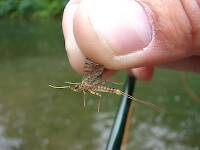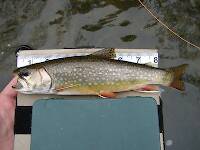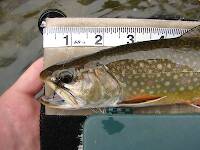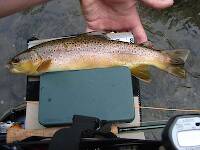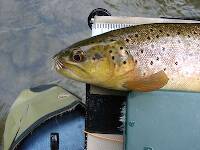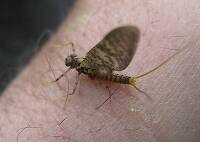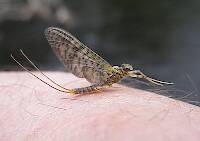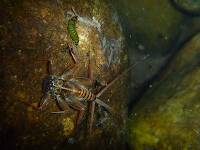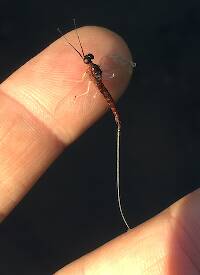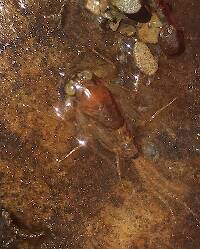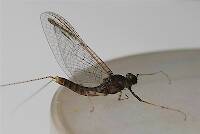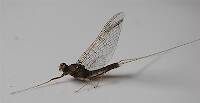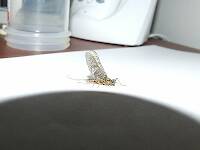
Hex Mayflies
Hexagenia limbata
The famous nocturnal Hex hatch of the Midwest (and a few other lucky locations) stirs to the surface mythically large brown trout that only touch streamers for the rest of the year.
Featured on the forum

Nymphs of this species were fairly common in late-winter kick net samples from the upper Yakima River. Although I could not find a key to species of Zapada nymphs, a revision of the Nemouridae family by Baumann (1975) includes the following helpful sentence: "2 cervical gills on each side of midline, 1 arising inside and 1 outside of lateral cervical sclerites, usually single and elongate, sometimes constricted but with 3 or 4 branches arising beyond gill base in Zapada cinctipes." This specimen clearly has the branches and is within the range of that species.

Troutnut is a project started in 2003 by salmonid ecologist Jason "Troutnut" Neuswanger to help anglers and
fly tyers unabashedly embrace the entomological side of the sport. Learn more about Troutnut or
support the project for an enhanced experience here.
Shawnny3 on May 20, 2009May 20th, 2009, 3:05 pm EDT
Based on my level of expertise, I'd say it's a fly, possibly a mayfly. I'll leave it to others to either correct me or narrow it down from there.
-Shawn
-Shawn
Jewelry-Quality Artistic Salmon Flies, by Shawn Davis
www.davisflydesigns.com
www.davisflydesigns.com
Catskilljon on May 20, 2009May 20th, 2009, 3:17 pm EDT
You are a clever one Shawn!
Mayfly, yes... you are probably right lol
I was thinking Grey Fox, anyone? CJ
Mayfly, yes... you are probably right lol
I was thinking Grey Fox, anyone? CJ
GONZO on May 20, 2009May 20th, 2009, 3:34 pm EDT
CJ,
Your mayfly--yes, Shawn guessed right!--is a female Maccaffertium spinner of one of the species known to fly fishers as Light Cahills or Cream Cahills. The females of some of these species are so similar that they defy identification to the species level, but this looks most like either M. modestum or M. mediopunctatum to me. Their emergence on larger, warmer rivers like the lower Delaware can be quite a bit earlier than on trout streams.
PS--I believe that if you change the IMG to lower case, your photo should magically appear. Meanwhile, here is a very similar example from Jason's collection: http://www.troutnut.com/specimen/296
(As a side note, my species suggestion on Jason's specimen was partly based on its association with a male that seemed identifiable.)
Your mayfly--yes, Shawn guessed right!--is a female Maccaffertium spinner of one of the species known to fly fishers as Light Cahills or Cream Cahills. The females of some of these species are so similar that they defy identification to the species level, but this looks most like either M. modestum or M. mediopunctatum to me. Their emergence on larger, warmer rivers like the lower Delaware can be quite a bit earlier than on trout streams.
PS--I believe that if you change the IMG to lower case, your photo should magically appear. Meanwhile, here is a very similar example from Jason's collection: http://www.troutnut.com/specimen/296
(As a side note, my species suggestion on Jason's specimen was partly based on its association with a male that seemed identifiable.)
Wiflyfisher on May 21, 2009May 21st, 2009, 12:19 am EDT
Jason's collection: http://www.troutnut.com/specimen/296
I use to think that was a S. fuscum spinner when I saw that on the Namekagon River.
John S.
https://WiFlyFisher.com
https://WiFlyFisher.com
GONZO on May 21, 2009May 21st, 2009, 5:49 am EDT
Yeah, CJ's guess was "Grey Fox" as well. But even under the previous concept of fuscum, the stigmal dots along the sides of the abdomen would be obscure (rather than the distinct little black dots seen in the specimens above), the rear half of the dorsal abdominal segments would be shaded brown (rather than have a narrow black line at the rear), and there would probably be a brown longitudinal stripe down the middle of the dorsal abdomen.
If you can tolerate a little unsolicited commentary on some aspects the fuscum/vicarium confusion/synonymy, read on (if not, don't):
The notion that fuscum was necessarily smaller than vicarium contains an element of misconception, though it is supported by some of the older scientific literature. Depending on the source, the size range for fuscum was supposed to be somewhere between 9-14mm. When Lewis (1974) published one of the last assessments of Stenonema done before fuscum and vicarium were synonymized, he listed the size of mature fuscum nymphs as 10-12mm. But even among the limited examples on this site, you can find exceptions to this. Here is a nymph that would have been classified as fuscum under the old scheme, yet it is already 15mm in April and is not yet fully mature (as evidenced by the short wingcases):
http://www.troutnut.com/specimen/479
The identification as fuscum would have been based on the markings at the rear of the ventral abdomen. Under the old scheme, fuscum had a dark patch on either side (as seen in this specimen), while vicarium had a solid dark band across the rear. However, many variations exist between the two: three dark patches (one in the middle), three dark patches that are connected together, and a dark band that contains a light spot near each cercus base. These are a few of the morphological traits that turned out to be variable or unreliable, and probably contributed to the synonymy.
That said, recent preliminary DNA evidence does seem to suggest that there are two "cryptic" species within what we now know as vicarium. Perhaps vicarium is indeed a species complex, but scientists have yet to discover reliable morphological traits to distinguish between the species. Whatever the case, I think it is unlikely that the "size and color" distinctions traditionally used by fly fishers to distinguish between "March Browns" and "Gray Foxes" will be validated. For the most part, those characteristics have already proved to be unreliable.
If you can tolerate a little unsolicited commentary on some aspects the fuscum/vicarium confusion/synonymy, read on (if not, don't):
The notion that fuscum was necessarily smaller than vicarium contains an element of misconception, though it is supported by some of the older scientific literature. Depending on the source, the size range for fuscum was supposed to be somewhere between 9-14mm. When Lewis (1974) published one of the last assessments of Stenonema done before fuscum and vicarium were synonymized, he listed the size of mature fuscum nymphs as 10-12mm. But even among the limited examples on this site, you can find exceptions to this. Here is a nymph that would have been classified as fuscum under the old scheme, yet it is already 15mm in April and is not yet fully mature (as evidenced by the short wingcases):
http://www.troutnut.com/specimen/479
The identification as fuscum would have been based on the markings at the rear of the ventral abdomen. Under the old scheme, fuscum had a dark patch on either side (as seen in this specimen), while vicarium had a solid dark band across the rear. However, many variations exist between the two: three dark patches (one in the middle), three dark patches that are connected together, and a dark band that contains a light spot near each cercus base. These are a few of the morphological traits that turned out to be variable or unreliable, and probably contributed to the synonymy.
That said, recent preliminary DNA evidence does seem to suggest that there are two "cryptic" species within what we now know as vicarium. Perhaps vicarium is indeed a species complex, but scientists have yet to discover reliable morphological traits to distinguish between the species. Whatever the case, I think it is unlikely that the "size and color" distinctions traditionally used by fly fishers to distinguish between "March Browns" and "Gray Foxes" will be validated. For the most part, those characteristics have already proved to be unreliable.
Martinlf on May 21, 2009May 21st, 2009, 6:01 am EDT
John,
Concerning vicarium it may be helpful to quote Gonzo to add a bit more information:
Concerning vicarium it may be helpful to quote Gonzo to add a bit more information:
The former Stenonema fuscum was synonymized under Stenonema vicarium by Bednarik and McCafferty in 1979. That same year, Bednarik also proposed "Maccaffertium" as a subgenus of Stenonema. Maccaffertium was then elevated to genus level by Wang and McCafferty in 2004, leaving only Stenonema femoratum in the genus Stenonema. That combination produced Maccaffertium vicarium as we know it now.
"He spread them a yard and a half. 'And every one that got away is this big.'"
--Fred Chappell
--Fred Chappell
Konchu on May 21, 2009May 21st, 2009, 9:05 am EDT
Gonzo: Is it vicarium or modestum that you have heard has the cryptics? Or both? I'm aware of research on the latter, but not necessarily the former.
Wiflyfisher on May 21, 2009May 21st, 2009, 10:38 am EDT
I always went by Hatches (original version)...
S. fuscum 12-14 mm more amber brown than S. vicarium and 2-4 mm smaller.
I guess life just got easier for fly fishers... Just call them all M. vicarium. :)
Thanks!
S. fuscum 12-14 mm more amber brown than S. vicarium and 2-4 mm smaller.
I guess life just got easier for fly fishers... Just call them all M. vicarium. :)
Thanks!
John S.
https://WiFlyFisher.com
https://WiFlyFisher.com
Catskilljon on May 21, 2009May 21st, 2009, 12:06 pm EDT
Yowww! Man you guys are something! Thanks Gonzo. CJ
Shawnny3 on May 21, 2009May 21st, 2009, 2:08 pm EDT
Glad to have helped, John. Nice ancillary comments, Gonzo.
-Shawn
-Shawn
Jewelry-Quality Artistic Salmon Flies, by Shawn Davis
www.davisflydesigns.com
www.davisflydesigns.com
Martinlf on May 22, 2009May 22nd, 2009, 6:23 am EDT
Hey Shawn,
My dad used to say that everyone likes a little a$$ every now and then, but nobody likes a smarta$$.
All kidding aside, thanks for that brilliant primary identification.
--Loua$$
My dad used to say that everyone likes a little a$$ every now and then, but nobody likes a smarta$$.
All kidding aside, thanks for that brilliant primary identification.
--Loua$$
"He spread them a yard and a half. 'And every one that got away is this big.'"
--Fred Chappell
--Fred Chappell
Shawnny3 on May 22, 2009May 22nd, 2009, 1:56 pm EDT
I try to contribute where I can, Louis. If that amuses some, so be it. But after reading so many I.D. threads in which I was dizzied by Konchu and Gonzo, I finally saw an opportunity to be of some assistance, and I was darned well going to take it.
-Shawn
-Shawn
Jewelry-Quality Artistic Salmon Flies, by Shawn Davis
www.davisflydesigns.com
www.davisflydesigns.com
Martinlf on May 22, 2009May 22nd, 2009, 4:13 pm EDT
I know what you mean. Konchu I can understand; he's trained. But where does Gonzo get off knowing all this stuff? Perhaps I should be picking on him. But I do owe you.
"He spread them a yard and a half. 'And every one that got away is this big.'"
--Fred Chappell
--Fred Chappell
GONZO on May 23, 2009May 23rd, 2009, 1:40 pm EDT
Konchu,
The suggestion of possible cryptics within M. vicarium came from the JNABS "barcoding" paper by Ball, Hebert, Burian, and Webb (2005). After discussing the possibility of cryptics within (or around) Maccaffertium modestum, they say this:
Based on the suggestion in this paper, some fly fishers might be tempted to say "See, I told you that March Browns and Gray Foxes were different species!" But the sequence divergence between vicarium groups was small when compared to the divergences that separated 3 distinct groups within Stenacron interpunctatum (the other "case" referred to above). Divergences between groups within that species ranged from 10%-17%.
However, interspecific divergence (between congeners) ranged from 3.3% to 25.8% in the study, and the divergence of the vicarium groups was within the lower part of that range. (The difference between Baetisca laurentina and B. lacustris was 3.8%, and the difference between Caenis lattipennis and C. youngi was 3.3%.) It should also be noted that samples in this study were very small--the purpose of the study was to test the use of DNA "barcoding" for identification purposes, not to discover cryptic species.
The suggestion of possible cryptics within M. vicarium came from the JNABS "barcoding" paper by Ball, Hebert, Burian, and Webb (2005). After discussing the possibility of cryptics within (or around) Maccaffertium modestum, they say this:
Evidence for additional cryptic species was encountered in 2 other cases, but these lineages formed sister taxa. Maccaffertium vicarium specimens clustered in 2 distinct groups, showing 3.4% sequence divergence, the upper limit of the intraspecific divergences we observed.
Based on the suggestion in this paper, some fly fishers might be tempted to say "See, I told you that March Browns and Gray Foxes were different species!" But the sequence divergence between vicarium groups was small when compared to the divergences that separated 3 distinct groups within Stenacron interpunctatum (the other "case" referred to above). Divergences between groups within that species ranged from 10%-17%.
However, interspecific divergence (between congeners) ranged from 3.3% to 25.8% in the study, and the divergence of the vicarium groups was within the lower part of that range. (The difference between Baetisca laurentina and B. lacustris was 3.8%, and the difference between Caenis lattipennis and C. youngi was 3.3%.) It should also be noted that samples in this study were very small--the purpose of the study was to test the use of DNA "barcoding" for identification purposes, not to discover cryptic species.
Martinlf on May 25, 2009May 25th, 2009, 3:23 am EDT
Shawn,
See what I mean? It's almost scary.
See what I mean? It's almost scary.
"He spread them a yard and a half. 'And every one that got away is this big.'"
--Fred Chappell
--Fred Chappell
Falsifly on May 25, 2009May 25th, 2009, 4:53 am EDT
WOW Gonzo!!! I can’t speak for the rest of us, but your last post left me absolutely “dun shucked”.
Falsifly
When asked what I just caught that monster on I showed him. He put on his magnifiers and said, "I can't believe they can see that."
When asked what I just caught that monster on I showed him. He put on his magnifiers and said, "I can't believe they can see that."
GONZO on May 25, 2009May 25th, 2009, 7:06 am EDT
Shawn, Louis, and Falsifly,
Some will probably think that you are unduly impressed by my ability to read, a handy little skill that I picked up between recesses in grade school. However, I admit that it wasn't an easy skill to acquire; I was often distracted from that task by observing the intraspecific morphological variations among the girls in my class. I have also developed the ability to walk upright (most of the time) and to use opposable thumbs (for a few rudimentary tasks). :)
Some will probably think that you are unduly impressed by my ability to read, a handy little skill that I picked up between recesses in grade school. However, I admit that it wasn't an easy skill to acquire; I was often distracted from that task by observing the intraspecific morphological variations among the girls in my class. I have also developed the ability to walk upright (most of the time) and to use opposable thumbs (for a few rudimentary tasks). :)
Taxon on May 25, 2009May 25th, 2009, 10:36 am EDT
Lloyd-
I think you are being far too modest. Louis is on to something here. I notice (at least) one darned sharp entomologist on BugGuide is now deferring to your opinions on mayfly identification. I am hoping your next book will be on entomology. And, if you think I'm kidding, let me assure you, I am not.
I think you are being far too modest. Louis is on to something here. I notice (at least) one darned sharp entomologist on BugGuide is now deferring to your opinions on mayfly identification. I am hoping your next book will be on entomology. And, if you think I'm kidding, let me assure you, I am not.
GONZO on May 27, 2009May 27th, 2009, 6:07 am EDT
Thank you, Roger.
Quick Reply
Related Discussions
Topic
Replies
Last Reply
5
May 20, 2009
by GONZO
by GONZO
8
Mar 30, 2012
by Brookyman
by Brookyman
2
May 20, 2007
by Troutnut
by Troutnut
7
Mar 13, 2007
by Troutnut
by Troutnut
4
May 24, 2008
by Softhackle
by Softhackle
3
Jun 27, 2018
by Konchu
by Konchu
9
Jun 13, 2008
by Wiflyfisher
by Wiflyfisher
14
Mar 24, 2009
by GONZO
by GONZO








